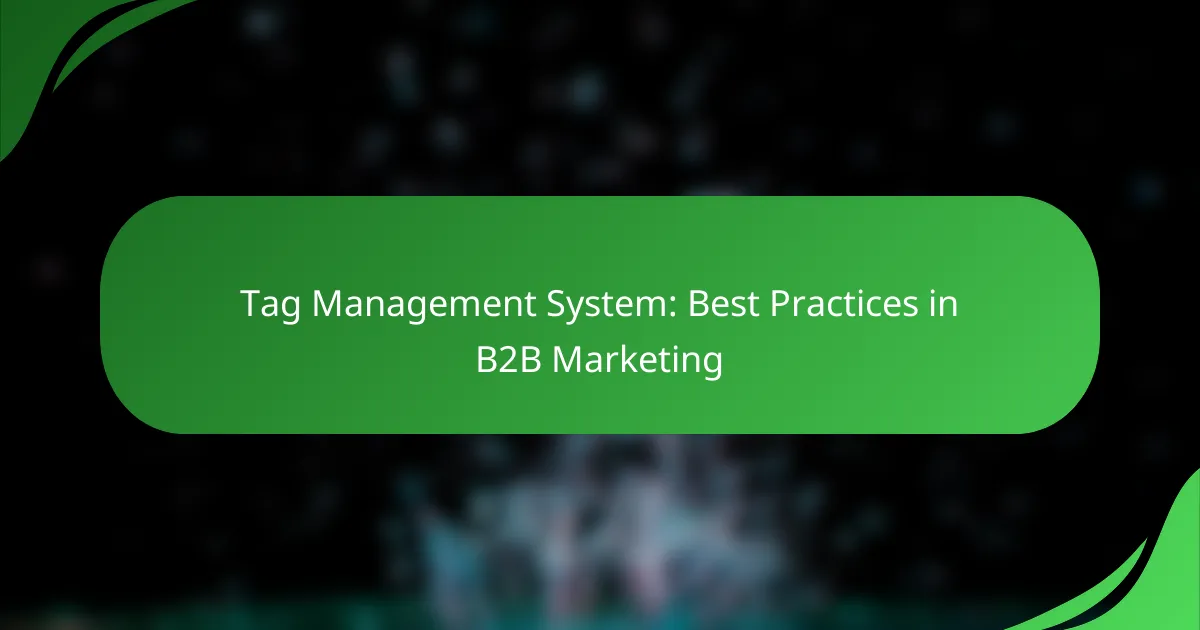Implementing a Tag Management System (TMS) is crucial for startups looking to enhance their marketing strategies and data accuracy. By centralizing tag deployment, a TMS streamlines tracking and analytics, allowing businesses to operate more efficiently while ensuring compliance with local regulations. Popular options like Google Tag Manager and Adobe Experience Platform Launch provide the flexibility and ease of use that startups need to succeed.

What are the implementation steps for a Tag Management System in Canada?
Implementing a Tag Management System (TMS) in Canada involves several key steps that ensure effective tracking and data management. These steps help startups streamline their marketing efforts and improve data accuracy while complying with local regulations.
Define tracking requirements
Start by identifying what you need to track, such as user interactions, conversions, or specific events. Clearly outline your goals to determine which tags are necessary for your business objectives.
Consider factors like the platforms you use (web, mobile, etc.) and the data you want to collect. This will guide your decisions on which tags to implement and how they should be configured.
Select a Tag Management System
Choose a TMS that fits your startup’s needs and budget. Popular options include Google Tag Manager, Adobe Launch, and Tealium, each offering different features and pricing structures.
Evaluate the ease of use, integration capabilities, and support options. A user-friendly interface can significantly reduce the learning curve for your team.
Set up user permissions
Establish user roles and permissions within your TMS to control access to sensitive data and configurations. This is crucial for maintaining security and ensuring that only authorized personnel can make changes.
Consider implementing a tiered access system where different team members have varying levels of permissions based on their responsibilities. This helps prevent accidental changes that could affect tracking accuracy.
Install the Tag Management System code
After selecting your TMS, you will need to install its code snippet on your website or application. This usually involves adding a small piece of JavaScript to the header and body sections of your site.
Follow the installation instructions provided by your TMS provider carefully to ensure proper functionality. Mistakes during this step can lead to tracking issues or data loss.
Configure tags and triggers
Once the TMS code is installed, configure your tags and triggers based on the tracking requirements you defined earlier. Tags are snippets of code that collect data, while triggers determine when these tags should fire.
For example, you might set a trigger to fire a tag when a user completes a purchase or clicks a specific button. Ensure that each tag is tested to confirm it collects data accurately.
Test and validate implementation
After configuring your tags and triggers, thoroughly test the implementation to ensure everything works as intended. Use tools like Google Tag Assistant or the built-in debugging features of your TMS to verify data collection.
Check for common issues such as tags not firing or incorrect data being sent. Validating your setup is essential to avoid discrepancies in your analytics and reporting.

Which Tag Management Systems are recommended for startups?
Startups should consider tag management systems (TMS) that offer flexibility, ease of use, and cost-effectiveness. Popular options include Google Tag Manager, Adobe Experience Platform Launch, and Tealium iQ Tag Management, each catering to different needs and technical capabilities.
Google Tag Manager
Google Tag Manager (GTM) is a widely used TMS that allows startups to manage and deploy marketing tags without extensive coding knowledge. Its user-friendly interface simplifies the process of adding and updating tags, making it ideal for teams with limited technical resources.
GTM supports a variety of tags, including those for Google Analytics, AdWords, and third-party services. Startups can benefit from its free pricing model, but they should ensure they have a clear tagging strategy to avoid clutter and maintain site performance.
Adobe Experience Platform Launch
Adobe Experience Platform Launch is a robust TMS designed for businesses looking for advanced capabilities and integration with Adobe’s suite of products. It offers a modular approach, allowing startups to select only the features they need, which can help manage costs effectively.
This platform is particularly beneficial for startups already using Adobe tools, as it provides seamless integration and enhanced data management capabilities. However, the learning curve may be steeper compared to simpler systems, so startups should allocate time for training and implementation.
Tealium iQ Tag Management
Tealium iQ Tag Management is known for its extensive integration options and real-time data capabilities. It is suitable for startups that require a comprehensive solution for managing multiple data sources and marketing technologies.
While Tealium offers powerful features, it typically comes with a higher price tag, which may be a consideration for budget-conscious startups. It’s essential to evaluate whether the advanced functionalities align with the startup’s growth plans and marketing strategies.

What are the benefits of using a Tag Management System?
A Tag Management System (TMS) simplifies the management of website tags, improving efficiency and effectiveness in tracking and analytics. By centralizing tag deployment, startups can enhance performance, accuracy, and marketing efforts.
Improved website performance
Implementing a TMS can significantly boost website performance by reducing load times and optimizing resource management. Tags are loaded asynchronously, meaning they do not block the rendering of the page, which can lead to faster user experiences.
Startups should regularly audit their tags to ensure only necessary ones are active. This practice can help maintain optimal performance and avoid unnecessary bloat, keeping page load times within low tens of milliseconds.
Enhanced data accuracy
A TMS enhances data accuracy by providing a single source of truth for all tracking codes. This centralization minimizes the risk of errors that can occur when managing tags manually across multiple platforms.
By using a TMS, startups can implement version control and testing features, allowing them to validate tags before deployment. This proactive approach helps ensure that the data collected is reliable and actionable, leading to better-informed business decisions.
Streamlined marketing efforts
With a TMS, marketing teams can quickly deploy and update tags without relying on IT resources, leading to faster campaign launches. This agility allows startups to respond to market changes and optimize campaigns in real-time.
Additionally, a TMS enables better collaboration among teams by providing a clear overview of all active tags and their purposes. Startups should leverage this transparency to align marketing strategies and improve overall campaign effectiveness.

What prerequisites are needed for implementing a Tag Management System?
To implement a Tag Management System (TMS), startups need a foundational understanding of web analytics, access to their website’s code, and training for their team on tag management practices. These prerequisites ensure that the TMS is effectively integrated and utilized to track user interactions and optimize marketing efforts.
Understanding of web analytics
A solid grasp of web analytics is crucial for effectively implementing a Tag Management System. Startups should familiarize themselves with key metrics such as page views, bounce rates, and conversion rates to make informed decisions based on data collected through tags.
Consider using popular analytics platforms like Google Analytics or Adobe Analytics as a reference point. This knowledge will help in setting up relevant tags that align with business goals and user behavior tracking.
Access to website code
Having access to the website’s code is essential for integrating the Tag Management System. This typically involves editing the HTML or JavaScript of the site to insert the TMS container code, which allows for the management of various tags without directly modifying the code each time.
Startups should ensure they have the necessary permissions or collaborate with their web development team to facilitate this process. It’s advisable to back up the website before making any changes to avoid potential disruptions.
Team training on tag management
Training the team on tag management is vital for maximizing the benefits of a TMS. This includes understanding how to create, modify, and troubleshoot tags, as well as how to analyze the data collected effectively.
Consider organizing workshops or online courses focused on TMS tools like Google Tag Manager. Regular training sessions can help keep the team updated on best practices and new features, ensuring the system is used to its full potential.

How to choose the right Tag Management System?
Choosing the right Tag Management System (TMS) involves assessing your specific needs, such as ease of use, scalability, and integration capabilities. A well-selected TMS can streamline your marketing efforts and enhance data accuracy across platforms.
Evaluate features and integrations
When evaluating features of a Tag Management System, consider the core functionalities such as user interface, version control, and debugging tools. A user-friendly interface can significantly reduce the learning curve, while robust debugging tools help identify issues quickly.
Integration capabilities are crucial as they determine how well the TMS will work with your existing tools and platforms. Look for a system that supports popular analytics and marketing platforms, allowing seamless data flow and reducing manual work.
Additionally, consider the flexibility of the TMS in adapting to your evolving needs. A system that offers customizable tags and supports various data types will be more beneficial in the long run. Check for compatibility with both current and future tools you may adopt.



